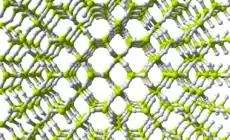Chromium(II) hydride
Chromium(II) hydride, systematically named chromium dihydride and poly(dihydridochromium) is pale brown solid inorganic compound with the chemical formula (CrH
2)
n (also written ([CrH
2])
n or CrH
2). Although it is thermodynamically unstable toward decomposition at ambient temperatures, it is kinetically metastable.
| Names | |
|---|---|
| Other names
Chromium dihydride | |
| Identifiers | |
| Properties | |
| CrH2 | |
| Molar mass | 54.0040 g/mol |
| Appearance | Colorless gas |
| Related compounds | |
Related compounds |
chromium(I) hydride Chromium hydride |
Except where otherwise noted, data are given for materials in their standard state (at 25 °C [77 °F], 100 kPa). | |
| Infobox references | |
Chromium(II) hydride is the second simplest polymeric chromium hydride (after chromium(I) hydride). In metallurgical chemistry, chromium(II) hydride is fundamental to certain forms of chromium-hydrogen alloys.
Nomenclature
The systematic name chromium dihydride, a valid IUPAC name, is constructed according to the compositional nomenclature. However, as the name is compositional in nature, it does not distinguish between compounds of the same stoichiometry, such as molecular species, which exhibit distinct chemical properties. The systematic names poly(dihydridochromium) and poly[chromane(2)], also valid IUPAC names, are constructed according to the additive and electron-deficient substitutive nomenclatures, respectively. They do distinguish the titular compound from the others.
Dihydridochromium
Dihydridochromium, also systematically named chromane(2), is a related compound with the chemical formula CrH
2 (also written [CrH
2]). It is both thermodynamically and kinetically unstable at ambient temperature with the additional propensity to autopolymerise, and so cannot be concentrated.
Dihydridochromium is the second simplest molecular chromium hydride (after hydridochromium), and is also the progenitor of clusters with the same stoichiometry. In addition, it may be considered to be the chromium(II) hydride monomer.
Molecular chromium(II) hydrides with the formulae CrH
2 and Cr
2H
4 have been isolated in solid gas matrices. The molecular hydrides are very unstable toward thermal decomposition. CrH2 is the major primary product in the reaction of laser-ablated chromium with molecular hydrogen. Dihydridochromium is the most hydrogenated, groundstate classical molecular hydride of chromium.[1] In the presence of pure hydrogen, dihydridochromim readily converts to bis(dihydrogen)dihydridochromium, CrH2(H2)2 in an exothermic reaction.
Properties
Acidity
An electron pair of a Lewis base can join with the chromium centre in dihydridochromium by adduction:
- [CrH
2] + :L → [CrH
2L]
Because of this capture of an adducted electron pair, dihydridochromium has Lewis acidic character. Dihydridochromium is a strong Lewis acid with the capacity to capture at least five electron pairs from Lewis bases.
It should be expected that chromium dihydride clusters and chromium(II) hydride have similar acid properties, although reaction rates and equilibrium constants are different.
Structure
In diluted chromane(2), the molecules are known to oligomerise forming at least dichromane(4) (dimers), being connected by covalent bonds. The dissociation enthalpy of the dimer is estimated to be 121 kJ mol−1.[1] CrH2 is bent, and is weakly repulsive to one hydrogen molecule, but attractive to two molecules of hydrogen. The bond angle is 118±5°.[2] The stretching force constant is 1.64 mdyn/Å.[2] The dimer has a distorted rhombus structure with C2h symmetry.
Production
Dichromane(4) is produced synthetically by hydrogenation. In this process, chromium and hydrogen react according to the reaction:
- Cr + H
2 → HCr(μ-H)
2CrH[1]
This process involves atomic chromium as an intermediate, and occurs in two steps. The hydrogenation (step 2) is a spontaneous process.
- Cr (s) → Cr (g)
- Cr (g) + H
2(g) → HCr(μ-H)
2CrH (g)
In an inert gas matrix atomic Cr reacts with H2 to make the dihydride when it is irradiated with ultraviolet light between 320 and 380 nm.[2] The reaction of chromium with molecular hydrogen is endothermic. 380 nm or greater wavelength radiation is required to procure photochemically generated CrH2.
History
In 1979 the simplest molecular chromium(II) hydride with the chemical formula CrH
2 (systematically named chromane(2) and dihydridochromium) was synthesised and identified for the first time. It was synthesised directly from the elements, in a reaction sequence which consisted of simultaneous sublimation of chromium to atomic chromium and thermolysis of hydrogen, and concluded with codeposition in a cryogenic argon matrix to form chromane(2).[3]
In 2003 the dimer with the chemical formula HCr(μ-H)
2CrH (systematically named dichromane(4) and di-μ-hydrido-bis(hydridochromium)) was synthesised and identified for the first time. It was also synthesised directly from the elements, in a reaction sequence which consisted of laser ablation of chromium to atomic chromium, followed by codeposition with hydrogen in a cryogenic matrix to produce chromane(2), and concluded with annealing to form dichromane(4).[1]
References
- Wang, Xuefeng; Andrews, Lester (30 January 2003). "Chromium hydrides and dihydrogen complexes in solid neon, argon, and hydrogen: Matrix infrared spectra and quantum chemical calculations". The Journal of Physical Chemistry A. 107 (4): 570–578. Bibcode:2003JPCA..107..570W. doi:10.1021/jp026930h.
- Xiao, Z. L.; Hauge, R. H.; Margrave, J. L. (January 1992). "Reactions and photochemistry of chromium and molybdenum with molecular hydrogen at 12 K". The Journal of Physical Chemistry. 96 (2): 636–644. doi:10.1021/j100181a024.
- van Zee, R. J.; de Vore, T. C.; Welner Jr., W. (1 September 1979). "CrH and CrH
2 molecules: ESR and optical spectroscopy at 4 °K [sic]". The Journal of Chemical Physics. 71 (5): 2051–2056. Bibcode:1979JChPh..71.2051V. doi:10.1063/1.438596.






